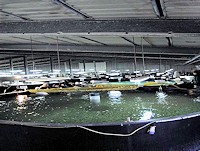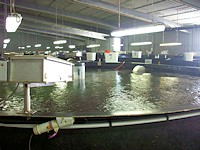Facility and equipment
The cages and tanks
 In
one shed sea bream and shi drum breeders are kept in fiberglass
tanks, while the sea bream hatchery occupy three others indoors
production areas. The sea bream and sea bass ongrowing phase is carried out outdoors in floating cages located in
the channel near the plant (12 tanks with sea bream) and in the Adriatic Sea opposite the mouth of the
channel. The floating cages are located between two
mussel plants which exploit the water and waste from the fish cages. The outdoor plant is comprised of 52 floating cages of
1000 and 680 m3. The sea bass cages are organized in a rectangle
In
one shed sea bream and shi drum breeders are kept in fiberglass
tanks, while the sea bream hatchery occupy three others indoors
production areas. The sea bream and sea bass ongrowing phase is carried out outdoors in floating cages located in
the channel near the plant (12 tanks with sea bream) and in the Adriatic Sea opposite the mouth of the
channel. The floating cages are located between two
mussel plants which exploit the water and waste from the fish cages. The outdoor plant is comprised of 52 floating cages of
1000 and 680 m3. The sea bass cages are organized in a rectangle 7 x
4 cages on the ground side while the sea bream cages (6 x 4) are
placed on the external side of the plant facing the open sea.
The incoming water drawn from the channel flows into the plant
at a rate of 500 m3/h; it is mechanically and biologically filtered
and sterilized by UV. The outgoing plant water undergoes the same
filtration and UV treatments. The water quality parameters are
regularly monitored with no substantial differences between in and
out waters.
7 x
4 cages on the ground side while the sea bream cages (6 x 4) are
placed on the external side of the plant facing the open sea.
The incoming water drawn from the channel flows into the plant
at a rate of 500 m3/h; it is mechanically and biologically filtered
and sterilized by UV. The outgoing plant water undergoes the same
filtration and UV treatments. The water quality parameters are
regularly monitored with no substantial differences between in and
out waters.
Feeding plant
 Feeding varies depending on the physiological growing
phase. Phytoplankton and rotifers are produced in the farm and
distributed at the beginning of the hatchery phase, while inert feed
is distributed during the ongrowing phase by automated feeders.
Fish growing in the floating cages are fed
to satiety by an automatic feeders on board of the boat which can
carry 3 tons of feed and can be managed by only one person.
Cylindrical
photo-bioreactors are used for the microalgae production, while the
rotifers are grown in square tanks. The practical feed for growing
phases is bought from feed industries.
Feeding varies depending on the physiological growing
phase. Phytoplankton and rotifers are produced in the farm and
distributed at the beginning of the hatchery phase, while inert feed
is distributed during the ongrowing phase by automated feeders.
Fish growing in the floating cages are fed
to satiety by an automatic feeders on board of the boat which can
carry 3 tons of feed and can be managed by only one person.
Cylindrical
photo-bioreactors are used for the microalgae production, while the
rotifers are grown in square tanks. The practical feed for growing
phases is bought from feed industries.
Transportation and grading
 Mechanical grading is used to select fish sizes and build
homogeneous groups in terms of weight and size. Hydraulic pumps are used for fish transfer.
Mechanical grading is used to select fish sizes and build
homogeneous groups in terms of weight and size. Hydraulic pumps are used for fish transfer.
Laboratory
The equipment for monitoring the plant includes:
- oxymeter
- pH-meter
- salinometer
A computer controls the photoperiod applied to the breeders tanks in order to maintain different groups spawning during the entire year. The laboratory is equipped with:
- optical microscope
- autoclave
- heaters
- thermostats
- shakers
- centrifuges
- laminar air flow cabinet.
The routine activities in the laboratory are: the preparation of fertilizer solutions for microalgae cultures, the preparation of small volumes of microalgae, the microbiologic and parasitological control of the final product. The research activities are focused on:
- new species reproduction
- improving the plant
- improving feeding
- improving reproductive efficiency.